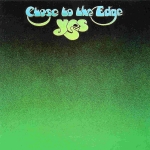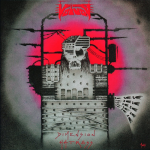The recording history of many long-term bands goes through various phases from the first bold debut album to the creation of the signature master piece and everything else in between and afterward. Some bands will find a new musical path and over the course of three albums they will really develop their music, often but not necessarily culminating in their frequently cited best work. Where they go after that often includes major line-up changes, a new musical direction, or a further step down the same path that just can’t compare to their “classic” years. I have in my collection some of these peaks of creativity and successful formulation which tend to span three albums. The criteria for a band’s catalogue to be included in my “Trios” of albums are fairly simple:
1) They must be three consecutive studio albums of normal length. No live albums, double albums, movie soundtracks, compilations, or others.
2) The three albums should show the band striving to develop their sound in its “classic” phase or to reach its “classic” sound.
For some bands it is a fairly easy task to identify three albums. For others there could easily be other opinions.
 Yes
Yes
After their bold but difficult album with an orchestra, Yes experienced some discontent in its ranks, mostly from guitarist Peter Banks who felt that the orchestra had taken over many of his parts. Whether he quit or was fired depends on who was asked; however, his departure from the band permitted the acquisition of Steve Howe, who was with Yes about to explode his talent across the world.
The first album to feature Steve and to truly begin to define the classic Yes sound was “The Yes Album” which included the hit song “I’ve Seen All Good People”. Following this album, the band wished to add more synthesizer keyboards to their sound but keyboardist Tony Kaye was insistent about sticking to the Hammond organ. Tony was let go, and another bright new star was welcomed to the band roster: Rick Wakeman. The second album with Steve Howe and the first with what is most often considered the classic line-up was “Fragile”. This album also was the first of many to feature the artwork of Roger Dean. “Roundabout” was the song that really broke Yes solidly into the American market and insured that there was an audience waiting for them across the Atlantic. The third album in the Trio is “Close to the Edge”, an album that has earned its place as one of the defining progressive rock albums of the genre.
What happened after that? Drummer Bill Bruford left prior to the tour and Alan White stepped in behind the drums where he has remained ever since. The following album was the audacious double album with only four side-long songs, “Tales from Topographic Oceans”, an album considered genius by some, insane by others, and the first of a few Yes efforts that drove Rick Wakeman from the band.
 Genesis
Genesis
In a similar history, Genesis replaced two founding members after their second album as well, and acquired an amazing guitarist named Steve. But while Yes replaced members in stages, Genesis secured a new guitarist and a new drummer in time for their third album. With Steve Hackett and Phil Collins on board, the band took a grand step further into the musical direction they first broached on their second album, “Tresspass”. “Nursery Cryme” explored longer pieces with a more daring approach to composition and mixing of styles. The following album “Foxtrot” showed the band further pursuing this thread and delivered the 23-minute signature prog masterpiece, “Supper’s Ready”. Where all the elements best gelled for many fans and critics, however, was on the third album of this classic line-up, “Selling England by the Pound”. These three albums together capture Genesis in its most memorable period of progressive rock. The album after was, as with Yes, a double conceptual piece, “The Lamb Lies Down on Broadway”, after which saw the departure of vocalist Peter Gabriel.
 Rush
Rush
It’s not easy to do a single defining Trio for Rush for two reasons. The first is that Rush’s work seems to come out in pairs not trios; it’s very easy to find two consecutive albums that go well together but by the following album the band is off developing the next sound in their evolution. There are their first three albums which see them moving from their hard rock roots into progressive rock; their second, third, and fourth albums which illustrate this move from rock to prog even more and all feature Neal Peart on drums. But one might also cite “Permanent Waves”, “Moving Pictures”, and “Signals” as a good trio because of this period of the band’s abandonment of side-long conceptual pieces in exchange for shorter but nonetheless technical and creative songs and the further use of keyboards before they went looking for a new producer and ventured further down the path of 80’s rock. Since many fans see “Signals” as either the last of the rock albums or the first of the synth albums and are less pleased with it than the previous two releases, I’ll choose “Fly By Night”, “Caress of Steel”, and “2112” as my Trio.
Rush were still very much entrenched in their hard rock era when Neal Peart began taking over song-writing duties for the second album. Though “Fly By Night” was to include mostly short rock songs and a song or two left over from their old catalogue, Rush introduced their more progressive aspirations on a mini-epic story piece called “By-Tor and the Snow Dog”. This approach was further developed on the largely unsuccessful follow-up album “Caress of Steel” which included a three-part story piece called “The Necromancer” and a side-long conceptual piece comprised of several short pieces called “The Fountain of Lamneth”. The record company was not impressed with the shortage of singles material and the band was on the verge of being given the boot. However, the next effort, also featuring a side-long conceptual piece (and which made the record company execs throw their hands in the air in despair) was a monumental success. “2112” brought Rush all the recognition they needed to prove that their way was the correct way for them.
What happened next? Rush made a grand change in musical style and adopted a more progressive approach, largely shrugging off their 70’s hard rock sound for a more progressive heavy rock sound and recorded a remarkable pair of albums before once again changing their approach.
 Pink Floyd
Pink Floyd
Pink Floyd’s recording history is punctuated by side projects that sometimes led to a Pink Floyd album which was actually written for someone else, specifically a movie director. “Music from the Film, More” and “Obscured By Clouds” interrupt the flow of band studio albums in the early years, as does the double, partially live album “Ummagumma”. I’d love to have cited “Atom Heart Mother”, “Meddle”, and “Dark Side of the Moon” or “Meddle”, “Dark Side…”, and “Wish You Were Here” as Pink Floyd’s Trio but the movie soundtrack “Obscured By Clouds” is wedged chronologically in between “Meddle” and “Dark Side…” With the double album “The Wall” waiting a little further down the line, that leaves us only with “Dark Side of the Moon”, “Wish You Were Here”, and “Animals”. These make for a great Trio but what is lacking is the rise to success and accomplishment.
Ignoring “Obscured By Clouds”, I would choose “Meddle”, “Dark Side of the Moon”, and “Wish You were Here” as the best Trio because of the grand leaps the band was making departing from their unique brand of psychedelic space rock and developing a distinctive approach to the sound of rock music. This Trio also ends on a high note with “Wish…” being hugely successful and an undisputed high point in the band’s recording career. But as the criteria stands, this can’t be a real Trio.
 Saga
Saga
Saga appeared on the music scene with their 1978 self-titled debut and over the next three albums stayed close to the musical styling with which they carved out their classic sound of rock guitar coupled with pop synthesizer duelling together in a fashion suggestive of progressive rock. To add something new to popular music, they introduced a jigsaw puzzle of a conceptual piece: eight songs in a series called “Chapters” whose parts would be spread over four albums in random order. The first three albums – “Saga”, “Images at Twilight”, and “Silent Knight” – show the band travelling with great consistency down their own defined road and feature the same producer though each album has a different keyboard player. By their fourth album, Saga had gone to England and found a new producer who took them into the 80’s with a gradually sleeker pop sound. These first three albums make for a great Trio.
Another suggested Trio from Saga would be “Full Circle”, “House of Cards”, and “Marathon” which see a return to their classic sound and eight new Chapters. However, this later Trio is less attractive as “Marathon” was not regarded as a high point in their career, unlike “Silent Knight” which was the album before their biggest seller, “World’s Apart”.
 Voivod
Voivod
Starting out as a speed metal band in 1983, Voivod recorded two albums of differing approaches before striking out on a style of progressive metal that few have successfully emulated and with which none have left their mark as indelibly as Voivod. The Trio of albums “Killing Technology”, “Dimension Hatross”, and “Nothingface” show the band moving from their hard core punk / heavy metal crossbreed into polyrhythms, odd time signatures, abrupt pauses, unanticipated tempo changes, and dissonant chord experimentation. Though “Nothingface” is not as heavy as the previous two, this album is frequently considered a progressive metal masterpiece, while those who prefer Voivod’s early sound stand by “Killing Technology” and “Dimension Hatross”.
The next album in their catalogue, “Angel Rat” took their music in a decided turn away from their speed metal roots and saw the eventual departure of bassist Blackie.
 Deep Purple
Deep Purple
Adding new members is often the right ingredient for taking a band to new heights, as we saw with Yes and Genesis. In late 1969, Deep Purple switched record labels and fired their singer and bass player and brought in Ian Gillan and Roger Glover from the band Episode Six. After recording a live album with an orchestra and a studio single, Deep Purple went on to record a Trio of historic albums that put them solidly in the annals of rock music history. Combining the classically trained approach of lead instrumentalists Ritchie Blackmore and Jon Lord into a driving rock sound with a bluesy tinge in the required places, the band released “Deep Purple in Rock”, “Fireball”, and “Machine Head”, developing their sound until they reached their peak.
The fourth album by the classic “Mk. II” line-up was fraught with personality clashes between Gillan and Blackmore and largely owed its success to its predecessor, “Machine Head”. After this once again the singer and bass player were replaced.
 Bill Bruford: An Autobiography
Bill Bruford: An Autobiography Grumpy Old Rock Star and other wondrous stories by Rick Wakeman
Grumpy Old Rock Star and other wondrous stories by Rick Wakeman





